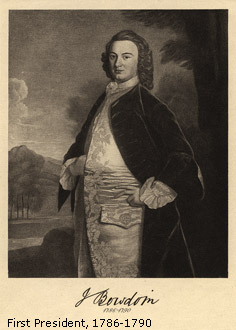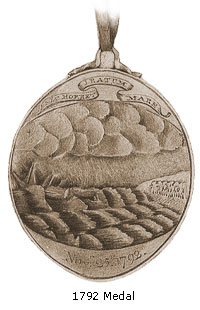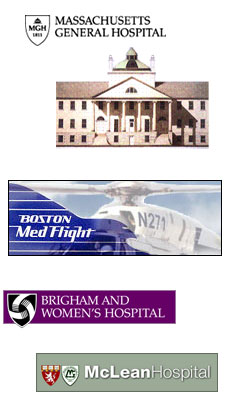 History of The Humane Society of the Commonwealth of Massachusetts
History of The Humane Society of the Commonwealth of Massachusetts
In 1785, a group of Boston citizens met several times at the "Bunch of Grapes"
tavern to consider the formation of an organization modeled on the British Royal Humane
Society. They were concerned about the needless deaths resulting from shipwrecks and
drownings and wanted to find ways to save lives.
Formally established in 1786, The Humane Society of the Commonwealth of Massachusetts elected
James Bowdoin, the governor of Massachusetts and the founder of Bowdoin College, to be its first
president. The other original trustees were Rev. John Clarke, Dr. Aaron Dexter, Rev. Dr. Simeon
Howard, Rev. Dr. John Lathrop, Rev. Samuel Parker, Dr. Isaac Rand, Dr. John Warren, Dr. Thomas
Welsh, Dr. Benjamin Waterhouse and Judge Oliver Wendell. In 1791, The Humane Society was formally
incorporated in the Commonwealth of Massachusetts.
From the outset, The Humane Society focused on recognizing selfless lifesaving rescues and
preventing such tragedies. It established an awards system with a financial stipend for those who
risked their lives to save others and presented its first award in 1786. By sponsoring public lectures
and publishing research studies, it encouraged innovative lifesaving techniques and resuscitation measures.
Its resources financed a number of firsts in the country: lifesaving huts and rescue boats along the coast,
swimming instruction for Boston public school students, instructional posters on resuscitation methods and
funding to create Massachusetts General Hospital, McLean Hospital and the Boston Lying-In Hospital.
Medal Awards Program

The Medal Awards Program was instituted before the country had such public safety organizations as
the US Coast Guard or local emergency response capabilities. The medal serves to provide recognition
for the rescue effort, and the accompanying financial stipend acknowledges that individuals take
extreme personal and economic risks to themselves and their families in attempting to save the lives
of others.
Andrew Sloane received the first medal in 1786 for saving a boy who broke through ice on a mill pond.
He was given 28 shillings. The program evolved into three medal categories based on the severity of the
rescue situation: silver, bronze and certificate. The Trustees continue to make a large number of awards
for rescues from drowning, but today they also consider a variety of emergency situations such as vehicle
and airplane accidents, fires and dog attacks where life is at risk.
Lifesaving Mission
The Humane Society's role in saving lives along the Massachusetts coast is a unique and compelling
story. Its work served as a model for the US Life-Saving Service and ultimately the US Coast Guard.
When The Humane Society was founded, survivors of shipwrecks might reach shore but often perished
because the isolated beaches lacked any protective shelter. To address this problem, The Humane
Society established huts and outfitted them with firewood and provisions to sustain survivors until
local townspeople came to their rescue. The first hut was placed at Scituate Beach in 1787. By 1806,
there were 18 huts along the coast and on Nantucket and Martha's Vineyard.
The Humane Society recognized that even more people could be saved if boats could be launched to
go through the surf. Intrigued by a new design for a lifesaving boat, the Trustees provided funds
for the construction of the first lifeboat in America. It was completed in 1807 and housed in
Cohasset. With additional funding provided by the Commonwealth of Massachusetts, the number of
lifeboats and boathouses along the coast expanded.
 By 1871, when the US Life-Saving Service (USLSS) was created, The Humane Society was responsible for
78 lifeboats and 92 huts, boathouses and other structures. Volunteers manned these facilities and all
were eligible for medal awards. Many of these volunteer leaders were the first to be hired for the new
USLSS. For several years, the USLSS and The Humane Society co-existed and often competed to be the first
on the scene of a disaster. During major storms, their joint efforts meant that more lives were saved
because neither organization could respond to all of the needs.
By 1871, when the US Life-Saving Service (USLSS) was created, The Humane Society was responsible for
78 lifeboats and 92 huts, boathouses and other structures. Volunteers manned these facilities and all
were eligible for medal awards. Many of these volunteer leaders were the first to be hired for the new
USLSS. For several years, the USLSS and The Humane Society co-existed and often competed to be the first
on the scene of a disaster. During major storms, their joint efforts meant that more lives were saved
because neither organization could respond to all of the needs.
In 1915, the USLSS and the Revenue Cutter Service were merged to form the US Coast Guard. The Humane
Society continued to maintain lifeboats and lifesaving stations along the Massachusetts coast through the
1930's and disposed of the last of its lifesaving equipment in 1946. As the US Coast Guard assumed more
responsibility along the coast, The Humane Society shifted its attention to lifesaving needs at rivers,
ponds and beaches and provided life-buoys that could be thrown to individuals who had fallen in or were in
distress. During the post-World War II period, the need for The Humane Society to deliver such services
declined as the public sector assumed greater responsibility.
A cooperative relationship between the US Coast Guard and The Humane Society was established in 2002
in a Memorandum of Understanding, affirming the shared history of the two institutions and their commitment
to improving safety on the waters.
Training and Education
Preventing tragedies on the water has always been a part of The Humane Society's lifesaving mission.
In 1798, The Society built a bathhouse on the Charles River because many Harvard students drowned while
bathing in the river. In the 1800's, swimming lessons were provided to Boston public school students and
a swimming school was established.
From the early 1900's to the 1970's, The Humane Society sponsored swimming instruction for children.
Working with the Red Cross and YMCA's, it hired instructors and conducted lessons at local Y facilities.
This practice expanded to include nonprofit camp facilities during the summer. In addition to swimming
instruction, courses were also offered in canoeing, boating and lifesaving. Over time, the nonprofit
organizations assumed responsibility for these programs, and The Humane Society moved on to other
initiatives.
In the mid-1960's, grants were made to Hurricane Island Outward Bound to build search and rescue craft
for use in their youth training and development programs. The Humane Society established a
relationship with the US Coast Guard Auxiliary, whose volunteers deliver extensive boating safety instruction
programs to the general public. The Auxiliary received funds for the purchase of computers with screen
projection capabilities, thereby improving the efficiency and quality of their course offerings.
Medical Research and Health Sciences
 From the beginning, The Humane Society recognized that improved methods were needed to resuscitate
drowning victims and to treat survivors. It sponsored public lectures, published research papers and
offered a premium in 1799 for the collection of facts about yellow fever. Some of its early treatises
advised blowing smoke into the lungs of drowning victims. This advice later evolved into the Prone
Pressure Method of Resuscitation that could also be used in cases of gas poisoning and electric shock.
From the beginning, The Humane Society recognized that improved methods were needed to resuscitate
drowning victims and to treat survivors. It sponsored public lectures, published research papers and
offered a premium in 1799 for the collection of facts about yellow fever. Some of its early treatises
advised blowing smoke into the lungs of drowning victims. This advice later evolved into the Prone
Pressure Method of Resuscitation that could also be used in cases of gas poisoning and electric shock.
The Humane Society also played an important role in the establishment of hospitals in Boston. Its grant
in 1796 helped to establish the Boston Dispensary, a foundling hospital. In 1818, the trustees made a $5000
challenge grant to help start Massachusetts General Hospital with half directed to the hospital for the sick
and the other half for a hospital for mental health patients (McLean Hospital) on the condition that another $20,000
be obtained from others for the same purposes. Its support in 1832 to establish the Boston Lying-In Hospital
for Women (currently Brigham and Women's Hospital) was similarly conditional on additional funds being secured.
Its role in medical research was actively revived in the 1970's with support of The Medical Foundation
for research fellowships. Other grants supported studies on cardiopulmonary resuscitation, hypothermia and
infant resuscitation. The Poison Information Center at Children's Hospital and the Burns Trauma Center at
Brigham & Women's Hospital also received funds. More recently, The Humane Society helped to equip the
Boston Med Flight helicopters with defibrillators and night vision goggles and to install portable ultrasound equipment in the
emergency rooms at five Boston hospitals.
Today, The Humane Society carries on the mission envisioned by its founders. It recognizes those who
voluntarily risk their lives to save others and seeks to prevent accident, injury and death primarily on
the waters.
 Contact:
Contact:
The Humane Society of
the Commonwealth of Massachusetts
Kathleen Davis, Executive Director
51 Grove Street, Suite A
Chestnut Hill, MA 02467
Tel. (617) 232-6242
|